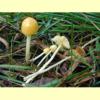_Bolbitius_vitellina_processed.jpg)
_Bolbitius_vitellina_processed_sml.jpg)

_sml.jpg)
_AF_06_sml.jpg)
The commonest species, Bolbitius titubans, often grows in lawns and has a pileus that, when young, is bright yellow and rather parabolic.
Bougher, N.L. (2009a), Fungi of the Perth region and beyond: a self-managed field book, Western Australian Naturalists' Club (Inc.), Perth. [Description and Illustration of B. titubans (as B. vitellinus) and B. titubans var. olivaceus]
Bougher, N.L. & Syme, K. (1998), Fungi of Southern Australia. University of Western Australia Press, Nedlands. [Description, Illustration and Microcharacters of B. titubans (as B. vitellinus and as B. variicolor)]
Breitenbach, J. & Kränzlin, F. (eds) (1995), Fungi of Switzerland. Volume 4. Agarics 2nd part. Edition Mykologia, Lucerne. [Description, Microcharacters and Illustration of B. titubans (as B. vitellinus)]
Fuhrer, B. (2005), A Field Guide to Australian Fungi. Bloomings Books, Hawthorn. [Description and Illustration of B. muscicola and B. titubans (as B. vitellinus)]
Grey, P. & Grey, E. (2005), Fungi Down Under. Fungimap, South Yarra. [Description, Illustration and Map for B. titubans (as B. vitellinus)]
Grgurinovic, C.A. (1997a), Larger Fungi of South Australia. The Botanic Gardens of Adelaide and State Herbarium and The Flora and Fauna of South Australia Handbooks Committee, Adelaide. [Description and Microcharacters of B. titubans (also as B. vitellinus)]
McCann, I.R. (2003), Australian Fungi Illustrated. Macdown Productions, Vermont. [Illustration of B. titubans (as B. vitellinus)]
Taylor, M. (1981), Mushrooms and Toadstools. A.H. & A.W. Reid, Wellington. [Illustration of B. muscicola from New Zealand]
Watling, R. (1982), British Fungus Flora. Agarics and Boleti. 3 / Bolbitaceae: Agrocybe, Bolbitius & Conocybe. Royal Botanic Garden, Edinburgh. [Description, B&W Illustration and Microcharacters of B. coprophilus, B. titubans (also as B. vitellinus and B. variicolor) along with Key to British species]
Watling, R. & Taylor, G.M. (1987), Observations on the Bolbitiaceae: 27. Preliminary account of the Bolbitiaceae of New Zealand, Biblioth. Mycol. 117: 1–61. [Description, Microcharacters and B&W Illustration of B. muscicola and and B. titubans (and as B. vitellinus) from New Zealand]
Young, A.M. (2005b), A Field Guide to the Fungi of Australia. University of New South Wales Press, Sydney. [Description and Illustration of B. titubans (as B. vitellinus)]
